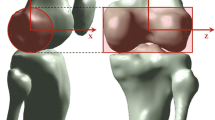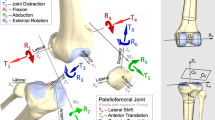Summary
Torque, angular velocity and angular position data were collected on six subjects performing maximum knee extensions at 11 speeds. Three-dimensional (3-D) surfaces were drawn for each subject and for the normalised, averaged data. For each subject, the moment arms of knee extensor and patella excursion were determined from radiographs and averaged across subjects. These data were then used to convert the angular data to linear force, velocity and information on muscle length. Surfaces were plotted for these data and evaluated. Results indicate a major difference between the knee positions for production of peak force or torque. Peak linear force was found to occur at an average of 75° of flexion, while peak torque was found at 57°. It was also suggested that 3-D surfaces provide more information than the traditional methods of presenting dynamic strength results.
Similar content being viewed by others
References
Abbott BC, Wilkie DR (1953) The relation between velocity of shortening and the tension length curve of skeletal muscle. J Physiol 120:214–223
Bahler AS, Fales JT, Zeirler KL (1968) The dynamic properties of mammalian skeletal muscle. J Gen Physiol 51:369–384
Blix M (1895) Die Lage und Spannung des Muskels. Skand Arch Physiol 5:150–206
Buff H-U, Jones LC, Hungerford DS (1988) Experimental determination of forces transmitted through the patello-femoral joint. J Biomech 21:17–23
Edgerton VR, Roy RR, Gregor RJ, Rugg S (1986) Morphological basis of skeletal muscle power output. In: Jones NL, McCartney N, McComas AJ (eds) Human muscle power. Human Kinetics, Champaign, Ill, pp 43–64
Edman KAP (1988) Double-hyperbolic force-velocity relation in frog muscle fibres. J Physiol 404:301–321
Evans CL, Hill AV (1914) The relation of length to tension development and heat production on contraction in muscle. J Physiol 49:10–16
Fenn WO, Marsh BS (1935) Muscular force at different speeds of shortening. J Physiol 85:277–297
Frankel VH, Burstein AH (1970) Orthopaedic Biomechanics. Lea and Febiger, Philadelphia
Fuglevand AJ (1987) Resultant muscle torque, angular velocity and joint angle relationships and activation patterns in maximal knee extension. In: Jonsson B (ed) Biomechanics X-A. Human Kinetics, Champaign, Ill, pp 559–565
Gordon AM, Huxley AF, Julian FJ (1966) Tension development in highly stretched vertebrate muscle fibres. J Physiol 184:143–169
Grood ES, Suntay WJ, Noyes FR, Butler DL (1984) Biomechanics of the knee extension exercise. J Bone Joint Surg 66-A:725–733
Herzog W (1988) The relation between the resultant moments at a joint and the moments measured by an isokinetic dynamometer. J Biomech 21:5–12
Huberti HH, Hayes WC, Stone JL, Shybut GT (1984) Force relations in the quadriceps tendon and ligamentum patellae. J Orthop Res 2:49–54
Lindahl O, Movin A (1967) The mechanics of extension of the knee joint. Acta Orthop Scand 38:226–234
Nisell R (1985) Mechanics of the knee. A study of joint and muscle load with clinical applications. Acta Orthop Scand [Suppl] 216:56
Partridge LD, Benton LA (1983) Muscle, the motor. In: Peachey LD (ed) Handbook of physiology – the nervous system II. American Physiological Society, Bethesda, pp 43–106
Perrine JJ (1986) Discussion comments. In: Jones NL, McCartney N, McComas AJ (eds) Human muscle power. Human Kinetics, Champaign, Ill, p 25
Perrine JJ, Edgerton VR (1978) Muscle force-velocity and powervelocity relationships under isokinetic loading. Med Sci Sports 10:159–166
Smidt GL (1973) Biomechanical analysis of knee flexion and extension. J Biomech 6:79–92
Sonnenblick EH (1965) Force velocity relations in mammalian heart muscle. Am J Physiol 202:931–939
Taylor NAS, Cotter JD, Stanley SN, Marshall RN (1989) Functional torque-velocity and power-velocity characteristics in elite athletes. In: Gregor RJ, Zernicke RL, Whiting WC (eds) Proceedings of the XII International Congress of Biomechanics. Los Angeles, USA. Abstract # 185
van Eijden TMGJ, Kouwenhoven E, Verburg J, Weijs WA (1986) A mathematical model of the patellofemoral joint. J Biomech 19:219–229
Wendt PP, Johnson RP (1985) A study of quadriceps excursion and the effect of patellectomy on cadaver knees. J Bone Joint Surg 67-A:726–732
Wickiewicz TL, Roy RR, Powell PL, Perrine JJ, Edgerton VR (1984) Muscle architecture and force-velocity relationships in humans. J Appl Physiol Respir Environ Exerc Physiol 52:435–443
Wilkie DR (1950) The relation between force and velocity in human muscle. J Physiol 110:249–280
Winter DA (1979) Biomechanics of human movement. Wiley, New York
Winter DA, Wells RP, Orr GW (1981) Errors in the use of isokinetic dynamometers. Eur J Appl Physiol 46:397–408
Yamaguchi GT, Zajac FE (1989) A planar model of the knee joint to characterize the knee extensor mechanism. J Biomech 22:110
Author information
Authors and Affiliations
Additional information
Currently on leave of absence from the University of Otago
Rights and permissions
About this article
Cite this article
Marshall, R.N., Mazur, S.M. & Taylor, N.A.S. Three-dimensional surfaces for human muscle kinetics. Eur J Appl Physiol 61, 263–270 (1990). https://doi.org/10.1007/BF00357610
Accepted:
Issue Date:
DOI: https://doi.org/10.1007/BF00357610




